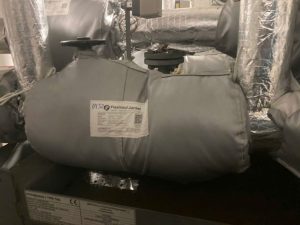Cheap Insulation: Instant Savings or a Long-Term “Trap”?
In a competitive industrial environment, optimizing operating costs is always a key challenge. Under budget pressure, insulation materials and insulation jackets are often seen as items where costs can be cut. Choosing a low-cost solution may seem reasonable at first, but this is a potential “trap”.
Mistakes in selecting poor-quality insulation not only reduce energy efficiency but can also cause serious equipment damage, affect workplace safety, and lead to huge long-term financial losses.
3 Critical Technical Mistakes When Choosing Cheap Insulation Jackets
Experience shows that problems from poor-quality insulation materials often do not appear immediately. They cause harm silently and only become apparent when the consequences are significant. Below are common mistakes that engineers must absolutely avoid.
Mistake #1: Underestimating the Material’s Operating Temperature Range
This is the most basic mistake, yet it causes the most severe consequences. Each type of insulation material is designed to work effectively within a specific temperature range.
- For high temperatures: Choosing a material with a heat tolerance lower than the pipe’s operating temperature will cause the material to decompose, shrink, or even burn. This not only completely eliminates its insulating capability but also creates a serious fire hazard.
- For low temperatures (cold insulation): Cheap materials often lack a closed-cell structure to prevent water vapor condensation. When moisture penetrates and freezes inside, it destroys the material’s structure, causing Corrosion Under Insulation (CUI) and loss of thermal efficiency.
Mistake #2: Ignoring the Impact of the Installation Environment
A factory environment involves more than just temperature. Chemicals, oil, moisture, and UV rays are factors that can destroy the insulation layer from the outside.
- Chemical resistance: Many cheap materials have very poor chemical resistance. When exposed to acid vapors, bases, or industrial solvents, they can corrode, soften, or lose their structural integrity.
- Moisture and UV rays: Insulation jackets used outdoors require a waterproof and UV-resistant outer cover. Low-cost products often have a thin cover that tears easily or degrades quickly under sunlight, allowing rain and moisture to penetrate, leading to CUI and damaging the entire inner insulation layer.
Mistake #3: The “Thicker is Better” Misconception
Many people assume that the thicker the insulation, the more effective it is. While thickness does affect the thermal resistance (R-value), it’s not the whole story.
- Thermal conductivity (K-value): Cheap materials often have a high K-value, meaning a significantly greater thickness is needed to achieve the same insulating effect as a premium material. This increases weight, takes up space, and may not be feasible in tight installation areas.
- Mechanical durability: Insulation jackets are often installed in areas with foot traffic and maintenance activities. Cheap materials are easily deformed or damaged upon impact, creating thermal bridges that reduce overall insulation effectiveness.
What’s the Solution for Engineers? Looking at Life Cycle Cost (LCC)
Instead of just looking at the initial purchase price, engineers should apply Life Cycle Cost (LCC) analysis. This analysis includes all costs associated with the insulation solution:
- Initial investment cost: Material purchase price and installation costs.
- Operating costs: Energy losses (heating or cooling costs) due to poor insulation performance.
- Maintenance & repair costs: The frequency and cost of replacing damaged insulation sections.
- Downtime costs (if any): Losses from having to shut down the system to fix insulation-related problems (e.g., repairing pipes affected by CUI).
When viewed holistically, a high-quality insulation jacket solution with a higher initial cost will often provide superior economic benefits in the long run. Investing in the right material from the start is a wise engineering decision that ensures performance, safety, and cost optimization for the entire system.
Request consultation and quotation now!Frequently Asked Questions
Why does cheap insulation end up being more expensive?
Because it often leads to higher energy costs from heat loss, frequent maintenance and repair costs, and the risk of equipment damage (like CUI), which can cause production downtime.
What is Corrosion Under Insulation (CUI)?
CUI is a type of corrosion that occurs on the surface of pipes or equipment when moisture gets trapped underneath the insulation material, causing severe and hard-to-detect damage.
How do you choose insulation material for high-temperature pipes?
You need to select a material with a maximum service temperature higher than the pipe’s operating temperature, while also considering its chemical resistance and mechanical durability in the installation environment.
Is thicker insulation always better?
Not necessarily. Insulation effectiveness primarily depends on the material’s thermal conductivity (K-value). A thinner, high-quality material can insulate better than a very thick, low-cost one.
What is Life Cycle Cost (LCC) analysis for insulation?
It is a method of calculating the total cost of ownership for an insulation system, including the initial purchase cost, energy loss costs, and maintenance and replacement costs over its entire lifespan.










